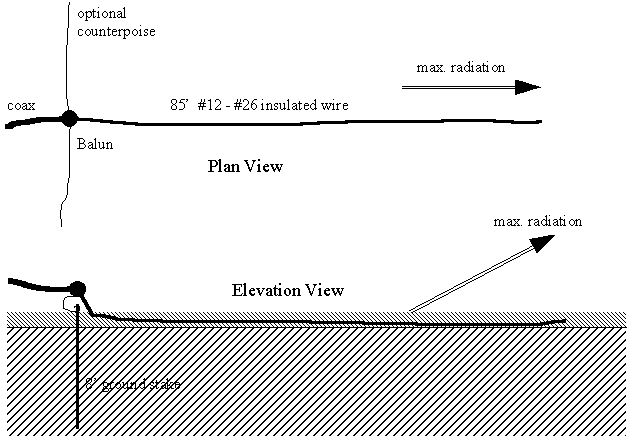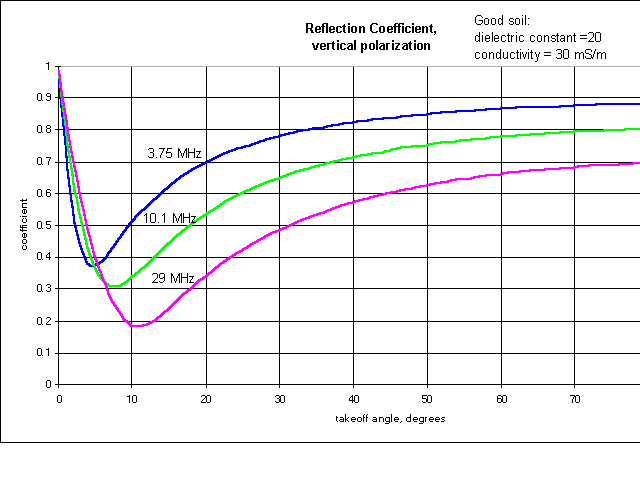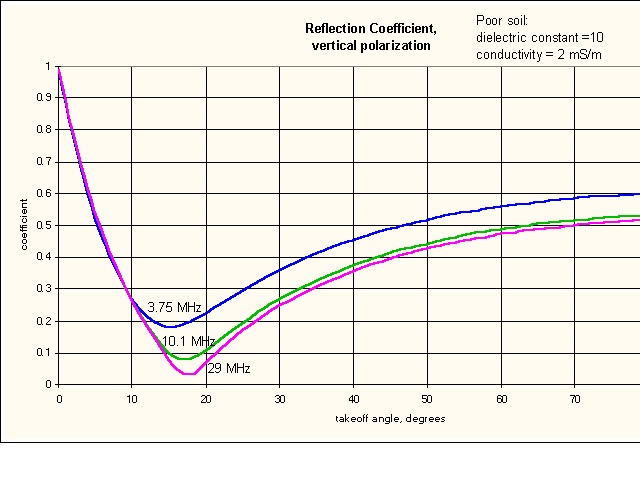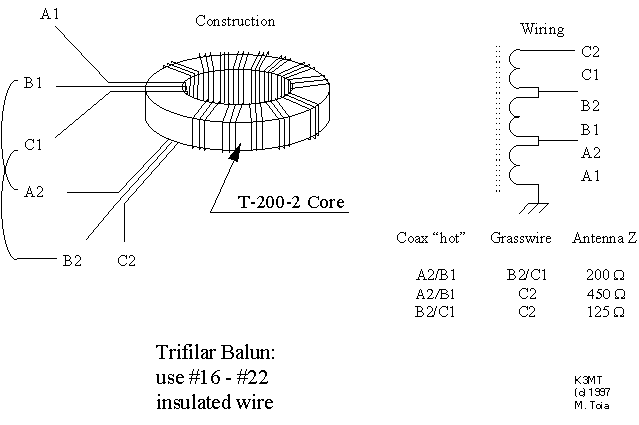
K3MT
presents . . .
Read on - and listen to the "experts" telling you that this is hogwash, that an antenna like this can't work. But it does. And true experts, who have taken a decade or more to come to grips with the intricasies of Maxwell's Math, know why it works.
This antenna will not out-perform a yagi, or a decent dipole up a half wavelength. Not in gain or signal strength, at least. But it will survive an ice storm, wind storm, and is practically immune to lightning. And it doesn't need a large tower or tall support. I deploy one from my hip pocket at times - the balun to match it is larger than the antenna!
THE GRASSWIRE - IN BRIEF
What is it? Put simply, it is an end-fed, longwire antenna that is laid right on the grass. Hence the name. The original grasswire used by K3MT in the summer of 1988 was just 204' of #18 AWG magnet wire laid along the property line, anywhere from 1" to 6" above the ground. This sketch shows plan and elevation views of a typical installation. Both an 8' ground rod and optional counterpoise wires are shown. Use one or the other. Both are not needed.

These antennas are largely resistive, with values ranging from 150 to 500 ohms or so on average ground. They have been used successfully on the average soils northwest of Washington, DC, on the sandy soils of the Cape Canaveral, Florida area, in the rocky, shale soils of the mountains in Somerset county, PA, and on river bottomland of Allegheny County, PA. One was used with great success by K3MT/VP9 in Southampton, Bermuda - the object of nightly pileups on 30 m CW for four nights.
REFLECTION AND THE BREWSTER ANGLE
The skeptic in you will doubt that such low antennas can work. After all, its image in the ground radiates and cancels out all radiation. True - if the ground is perfect. But nothing is perfect! The grasswire radiates vertically polarized off the end of the wire. Extensive monitoring tests with wires laid along the great circle route toward WWV, and perpendicular to that line, demonstrate the end-fire nature of the antenna. So why does it work?
When a plane wave reflects from an air-earth boundary, an incoming ray reflects, giving an outgoing ray. These two, and the line normal to the boundary plane, form a plane of incidence. Solutions of Maxwell's equations differ for the case of the E-field being perpendicular to this plane (i.e., horizontally polarized), and the case when the E-field vector is in the plane of incidence. You will probably call the latter "vertical" polarization, although this is technically not correct. Electromagneticists (a.k.a those who practice Electromagical effects) refer to these cases as normal incidence (horizontal polarization) and planar incidence (vertical polarization.)
For the normal incidence case, reflection is nearly total, with a nearly 180 degree phase reversal. Thus very low antennas neither respond to, nor generate, appreciable amounts of horizontally polarized radiation. But for the planar incidence case, the reflection varies in strength considerably. At some takeoff angle (angle between outgoing ray and the ground) the reflection becomes quite weak, and has a 90 degree phase shift. Near this angle, the sum of direct and reflected rays will have a magnitude as if the antenna were in free space! Of course, at other angles, ground reflection largely cancels the direct ray, and the antenna does not radiate well at all.
A reflection coefficient is calculated as the ratio of the electric field in the incoming ray to the electric field in the reflected ray. It varies from one (total reflection without loss) to zero (no reflection at all.) It depends on the takeoff angle, frequency, and the soil parameters (dielectric constant and conductivity.) Here are plots of planar incident (vertical polarization) reflection for typical "good" and "poor" soils.


Notice that, at 10 to 25 degrees, the ground reflection is very weak. It also is shifted 90 degrees in phase from the incident ray. Therefore, radiation from the grasswire, off the ends will be about the same as if the ground were not present.
But launching a ray at, say, 15 to 20 degrees takeoff angle, in a direction toward Europe, can be useful! That's what a grasswire does. It is lossy in all directions, but least lossy when exciting the ionosphere for a long-haul DX contact. To demonstrate the point, here's an extract of K3MT's log, for October of 1988, (ahh, glory! Yes, the SSN was good then!) using a grasswire:
Date GMT CALL his/my RST FREQ Power
OCTOBER
27 1554 SM6DYK 579 / 559 28004 80
1601 SM0LBR 569 / 439 21007 100 RAY - STOCKHOLM
2001 W4JBQ 579 / 569 7029 40 JOE - FT WRIGHT, KY
2141 W8LNJ 579 / 459 28015 80 DAVE - DALLAS, TX
28 0227 W8AO 589 / 569 3547 15 BOB - SILVER LAKE, OH
1720 G3RFE 579 / 559 21016 100 TOM - BARROW
1932 G0CBW 569 / 559 14029 50 MEL
1945 VE2FOU 589 / 559 7032 100 ANDRE - IBERVILLE
2026 KB7UX 569 / 539 21040 100 RUSS - CHINO VALLEY, AZ
2100 I2JIN 589 / 559 14022 40 BOB - COMO
2123 G3JVC 569 / 559 14022 40 JOHN - LONDON
29 2105 WA200JXT 599 / 599 28015 80 ND
Not bad, for a wire on the ground. Notice that contacts were made on 80, 40, 20, 15, and 10 meters. The signal reports are not fantastic. But contacts were made, and ham radio was enjoyed! Five countries were worked in 3 days. And the best part of this setup: the neighbors never knew that a ham station was on the air!
FEEDING THE GRASSWIRE
Since this antenna is largely resistive, a simple trifilar balun is all that I have ever had to use. This sketch shows how to make a balun that works:

Typically I pull the insulation off of some indoor telephone wiring cable. Four insulated #22 copper wires are inside: discard one of these and use the remaining three. Wind about 16 turns on the core, without allowing the wire to twist (keep the three conductors parallel at all times.)
Notice that this "balun" really matches an unbalanced antenna to an unbalanced transmission line. It is basically a wide-band, three-winding autotransformer. Impedance ratios are as shown on the drawing. Generally it is necessary to connect the coax to either A2/B1 or B2/C1, and the antenna to B2/C1 or to C2. This may change from one band to another, and usually does.
WINDOM IN THE GRASS
I have elsewhere described a windom antenna. While it is usually hung from a pole or in a tree, it works when used in a "grasswire" mode. Just lay it on the ground. Dimensions are repeated here for ready reference.

When I travel, I take one of these made of #22 insulated hookup wire. Since I often set up beside motel parking lots, and often after a day's work, the longer wire is black, and the shorter one is red. This helps me determine which way to point the windom. Remember, though, that it fires off the long end. Of course, it fires the other way, too, but usually works best off the long end.
I hope this has given some of you a good case of curiosity. Go out and try one of these ground - mounted wires. They're easy to build. Even the balun is easy to build.
If you must, contact us: we can supply a core, a whole balun, or a whole grasswire windom setup.
For more unusual antennas, visit my web page.
And check out my Books for a dozen topics about HF antennas.
that includes the grasswire and other beverage antennas.
73
K3MT